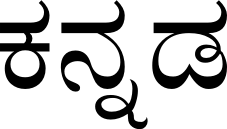Language/Kannada/Grammar/Consonants
Welcome! In this lesson, we will explore the consonants in the Kannada language. The Kannada script is derived from the ancient Brahmi script and is closely related to other scripts of the Dravidian languages, such as Tamil and Telugu. Kannada has a rich and interesting history and learning the consonants will help you better understand and communicate in this beautiful language.
Introduction to Kannada Consonants
Kannada has a total of 34 consonants that are grouped into three categories: gutturals, palatals, and cerebrals. They are further divided into five different classes: stops (oral and nasal), fricatives, affricates, approximants, and laterals.
In this lesson, we will focus on the basic consonants and their pronunciation. Each consonant in Kannada has an inherent vowel sound known as the schwa ('a') attached to it. When you write a consonant by itself, it is understood to have a 'ಅ' sound. We will also discuss how to write them and their corresponding sounds in the International Phonetic Alphabet (IPA) and Latin script.
Let's dive into the consonants!
Gutturals
Gutturals are consonants that are pronounced in the throat. Kannada has five guttural consonants:
| Kannada | Pronunciation (IPA/Latin) | English |
|---|---|---|
| ಕ | k | k as in 'cat' |
| ಖ | kh | kh as in 'inkhorn' |
| ಗ | g | g as in 'goat' |
| ಘ | gh | gh as in 'spaghetti' |
| ಙ | ŋ | ng as in 'sing' |
Palatals
Palatals are consonants that are pronounced by placing the tongue on the hard palate. Kannada has five palatal consonants:
| Kannada | Pronunciation (IPA/Latin) | English |
|---|---|---|
| ಚ | tʃ | ch as in 'change' |
| ಛ | tʃh | chh as in 'catcher' |
| ಜ | dʒ | j as in 'judge' |
| ಝ | dʒh | jh as in 'bujharatee' |
| ಞ | ɲ | ñ as in 'cañon' |
Cerebrals
Cerebrals, also known as retroflex consonants, are pronounced by curling the tip of the tongue back to the roof of the mouth. Kannada has five cerebral consonants:
| Kannada | Pronunciation (IPA/Latin) | English |
|---|---|---|
| ಟ | ʈ | ṭ as in 'tarka' |
| ಠ | ʈh | ṭh as in 'peetham' |
| ಡ | ɖ | ḍ as in 'ḍamaru' |
| ಢ | ɖh | ḍh as in 'padha' |
| ಣ | ɳ | ṇ as in 'purnima' |
Dentals
Dentals are consonants pronounced with the tongue touching the back of the upper front teeth. Kannada has five dental consonants:
| Kannada | Pronunciation (IPA/Latin) | English |
|---|---|---|
| ತ | t | t as in 'stop' |
| ಥ | th | th as in 'path' |
| ದ | d | d as in 'dog' |
| ಧ | dh | dh as in 'had' |
| ನ | n | n as in 'sand' |
Labials
Labials are consonants pronounced by closing or almost closing the lips. Kannada has five labial consonants:
| Kannada | Pronunciation (IPA/Latin) | English |
|---|---|---|
| ಪ | p | p as in 'pat' |
| ಫ | ph | ph as in 'uphill' |
| ಬ | b | b as in 'bat' |
| ಭ | bh | bh as in 'abhor' |
| ಮ | m | m as in 'man' |
Semi-vowels
Semi-vowels in Kannada are also called approximants. They are very similar to vowels, but are treated as consonants in the script. There are four semi-vowels in Kannada:
| Kannada | Pronunciation (IPA/Latin) | English |
|---|---|---|
| ಯ | j | y as in 'yes' |
| ರ | r | r as in 'rose' |
| ಲ | l | l as in 'late' |
| ವ | ʋ | v as in 'vine' |
Sibilants
Sibilants are a type of fricative consonants that produce a hissing sound when pronounced. Kannada has three sibilants:
| Kannada | Pronunciation (IPA/Latin) | English |
|---|---|---|
| ಶ | ʃ | sh as in 'she' |
| ಷ | ʂ | ṣ as in 'paṣu' |
| ಸ | s | s as in 'so' |
Fricative
The one additional fricative consonant in Kannada is:
| Kannada | Pronunciation (IPA/Latin) | English |
|---|---|---|
| ಹ | h | h as in 'house' |
Additional Consonants
Kannada has two additional consonants:
| Kannada | Pronunciation (IPA/Latin) | English |
|---|---|---|
| ಳ | ɭ | ḷ as in 'pūrṇima' |
| ಱ | rɭ | kr as in 'krīḍa' |
Practice Writing Consonants
Now that you have learned the consonants and their pronunciation, practice writing each character. Write them multiple times, and say the consonant sound out loud as you practice. This will help reinforce the connection between the written character and the sound it represents.
Conclusion
Congratulations! You have now learned the Kannada consonants, their pronunciation, and how to write them. Keep practicing, and soon you will be able to read and write words in Kannada with ease.
In the next lesson, we will explore Kannada conjuncts, their pronunciation, and how to write them. Keep practicing and stay persistent, and you'll be on your way to learning the beautiful Kannada language!

